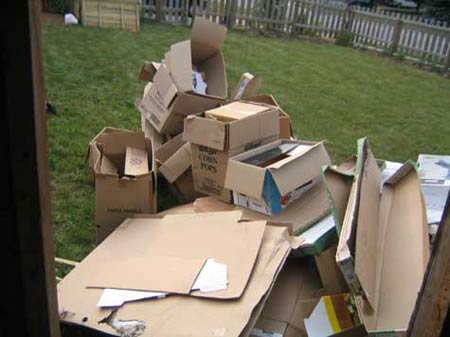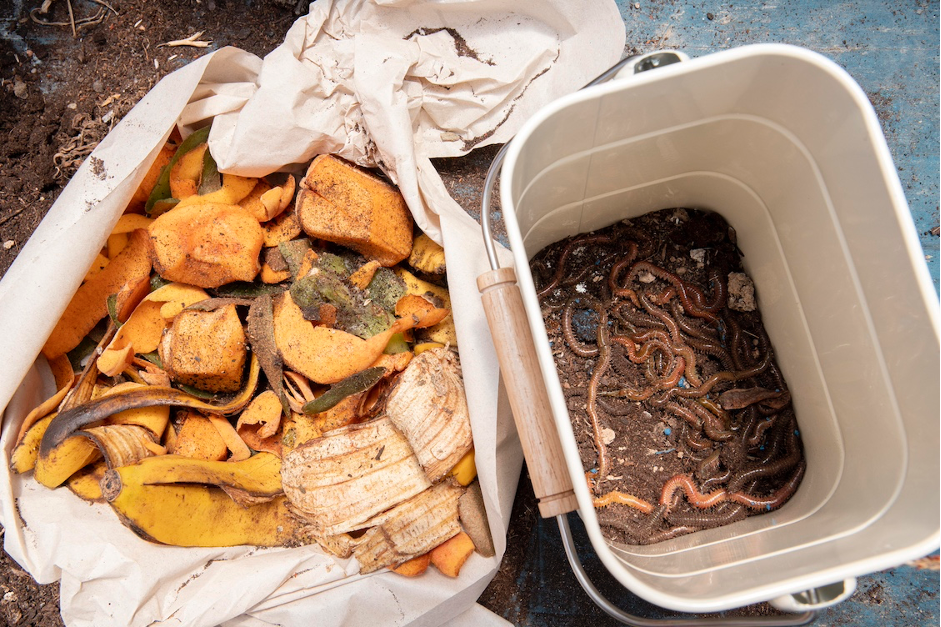 If you know one thing about red worms, it’s that they’re crazy about brown cardboard. After all, why not? It’s the perfect bedding, the perfect jungle-gym, and the most readily available foodstock.
If you know one thing about red worms, it’s that they’re crazy about brown cardboard. After all, why not? It’s the perfect bedding, the perfect jungle-gym, and the most readily available foodstock.Why Worms Like Brown Cardboard
 If you know one thing about red worms, it’s that they’re crazy about brown cardboard. After all, why not? It’s the perfect bedding, the perfect jungle-gym, and the most readily available foodstock.
If you know one thing about red worms, it’s that they’re crazy about brown cardboard. After all, why not? It’s the perfect bedding, the perfect jungle-gym, and the most readily available foodstock.Have you ever wondered why they eat it?
We’d like to jot down some of our thoughts on this topic and present some different theories that are floating around out there. We’d love to hear your feedback and hear your thoughts so be sure to leave a comment below!
Before we dive into some different theories, let’s first discuss what cardboard is comprised of.
First, there are two types – paperboard and cardboard. Paperboard is cereal boxes, 12-pack soda boxes, empty toilet paper rolls and the such. The other kind is corrugated cardboard. Corrugated cardboard uses glue to seal the corrugations. Paperboard does not have any glues holding it together, and the two are made differently. This is an important thing to remember as we talk about the theories below.
Theory 1: They like the cardboard glue. Corrugated cardboard is held together by glue – which is why it unravels and falls apart when wet – and also explains why certain places feel slippery when wet. This glue is said to be made from cornstarch, and therefore, contains nutrients in it. However, this is only a theory and there has been no substantial evidence on that front. Worms eat shredded paper and paperboard too, so the glue can’t be the only reason worms enjoy feeding on brown cardboard.
Theory 2: There is actual food found in cardboard. Cardboard collects and houses many species of fungi due to the fact that it’s a material that’s high-carbon and nitrogen. Secondly, since brown cardboard is often used to hold and transport organic foods, there is undoubtedly a small amount of food juices and rotting waste that seeps into the cardboard. This means you have a good chance of finding a microbial population in the cardboard and we all know worms love microbes.
There is a business in Vernalis, CA that used to use cardboard and paper sludge as their only feedstock. Now, they use bits of vegetable waste. But, it worked for a while!
At least we have some answers here. Undoubtedly there are more, so please share your ideas! Most importantly, the worms seem to thrive by brown cardboard and seem to love eating it! Don’t forget to shred, or cut up your brown cardboard to make it easier for the worms to digest and more suitable for bedding. Cardboard is the perfect bedding because it allows air and gases to flow freely, it holds water, keeping the worms moist and also absorbs water to prevent too much water from swamping your bedding!
Uncle Jim’s Worm Farm is a vermicomposting company that specializes in worm farms, kits and the famous red wiggler. The above image is not our own.
Image courtesy of www.ecosherpa.com









17 thoughts on “Why Worms Like Brown Cardboard”
I believe the answer is a combination of hypothesis #1 and #2.
The glue is a starch, which is a constituent of carbohydrates and the cardboard is fibrous. Cellulose material needs fungus to break down. Cardboard is also porus, so it will absorb water and hold on to it.
Worms and other composters feed on carbohydrates, fungus, and water. Everything damp cardboard has.
When i garden, i put down a thick layer of corrugated cardboard or newspapers (newspapers for smaller plots but i am using more and more cardboard). I don’t till, plow, or even remove any growth before carpeting the garden. I plop down a 5 gallon bucket of compost for every plant, then cover everything with raw wood mulch.
Weeding is minimal. Water retention is excellent. And the amount of worms i end up with 2 weeks later is insane, leaving all sorts of great castings behind.
In a worm book years ago, it said that worms loved cardboard because it was made of animal hooves. Thus cellulous I guess. It also said that “sewer sludge” was the absolute best food for growing large worms. Perhaps one could go down to the city sewer repository and ask for some sludge to feed your worms. LFL.
Cardboard is a GREAT bedding and cover for placing over a feed area in your bin. The shredded for bedding and flat section moistened to cover an area for the top feeders. The little guys seem to love it! It does break down slower than shredded newspaper though, so use that to your advantage when planning and placing bedding materials.
I do believe that old paper egg cartons are the ultimate “cardboard” as they seem to be 100% cellulose, provide some irregular surface area for microbes and aeration, holds moisture very well, and decomposes at about the same rate as newspaper. Mixing this with newspaper will get the perfect texture and density needed for your bin while all materials are usually readily available, free, and would be thrown away in most households.
I don’t have a worm bin. I only use shipping boxes. A larger box with holes resting as a lid, over the smaller box with holes. I make holes for airflow and drainage, just like you do with other bins. Easy enough to lift the top box and add my kitchen scraps. As the cardboard box absorbs liquid, and begins to soften, I split the load, into 2 new boxes. Then eventually, the worms double themselves, and I have 4 boxes.
Worms seem to do just fine living in my cardboard boxes. They eat my food scraps, and the softened cardboard box. The box serves as their bin, bedding, and food,. I don’t have to cut any of the cardboard into smaller pieces, as water does a great job of making the cardboard soft enough for the worms to eat. Cardboard soaks and absorbs liquid, so my worm bin is never oversaturated.
Amazon has kept me well supplied with worm boxes for years.
I’m new to vermicultura and my basic worm bedding is a mix of last year’s spent coir from nitrogen fixing plants 50/50 with brown cardboard processed into fluffy pulp. A handful of used coffee grounds are added in.
So far the worms seem very happy mostly eating the bedding with the banana skins that Ok chop then freeze overnight to break down the celular walls.
Would it be better if I added their feed as a fine mixture spread just under the surface of the bedding?
Thanks for any advice
Somewhere both of your theories are right. Worms love cardboard glue as well the fungi material gives them food. So, they love the brown cardboards and enjoy feasting upon these cardboards. It is nice and hope will come back for more next time. They offer same information here Ptlpackaging.co.nz, one must check them also.
Are brown paper bags from the grocery store as good as cardboard?
I really enjoy ed while reading your theories. Am agree with your satance.
Thanks for you to share with us !!!
Best,
Diana
wow ! thanks so much for your tips giving me a good picture of how simple this can be.I have plastic bins with lots of holes in both the tops and bottoms, but I realized that I don’t need the bins, I can just put cardboard boxes in the garden with cardboard lids, I have always been concerned about critters getting into them , we have alot of moles , ground squirrels , possums, raccoons, etc. what do you think?
Well informational.
Glad to know this first time Thanks to you for updating us .
keep continue this amazing work.
Best,
Eli
If the cardboard is shredded and exposed to the sun and weather for 6 months to a year (I am using it to mulch around some plants), will that make it a lot easier for the worms to digest/eat it? Or should I just shred it up, soak and drain the cardboard, and put it in their bin like any other carbon source?
Thanks.
Hello. I had a cardboard amazon box sitting in my house and found worms growing inside (they are tiny black and white worms). Our cat got in the box and spread them throughout the house. Does anyone know what type of worm this could be? They are about 1-3 mm in length and curl into a ball when touched.
Hi,
As a biologist I can say that both theories are correct, however theory #1 is just first stage of #2.
Let me explain. Worms feed on microbes and fungi. Both Cardboard itself as well as starch glue are feedstock for worms food. This is the reason worms do not bite and chew undecomposed cardboard. It is not yet soft enough and do not contain maximum population of microbes and fungi.
Couple tips.
Worms are using sand grains as crushers helping them break down the feedstock. Same readon birds ate using stones. It is therefore good idea to add to each bedding batch a handful of fine sand.
Also they do need a lot of calcium. So handfuls of lime or finely crushed egg shells is another boost.
Calcium will also help neutralize any acids being produced by decomposes.
Especially important if you feed microbes for worms with green stuff. It has high probability to go acidic if there is no lime around.
Thank you for sharing your expertise!
Uncle Jim’s Worm Farm
I really appreciate your article. Your article contains useful information which improves my knowledge. The custom box packaging facilitates you with the finest quality
I really enjoyed while reading your theories.
Thanks for you to share with us !!!
custom boxes